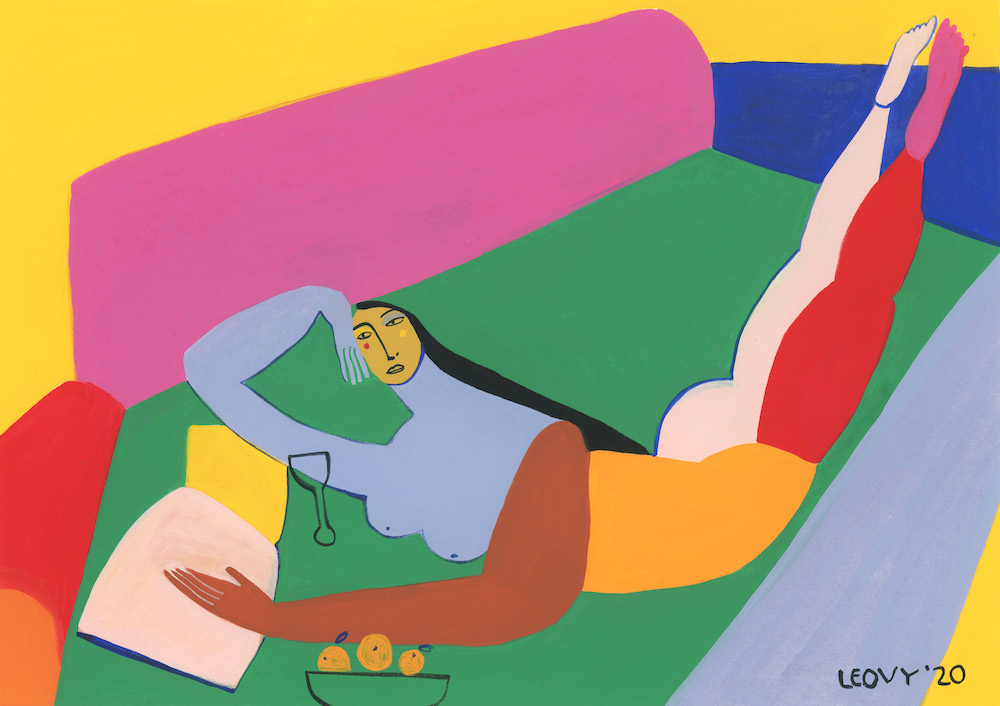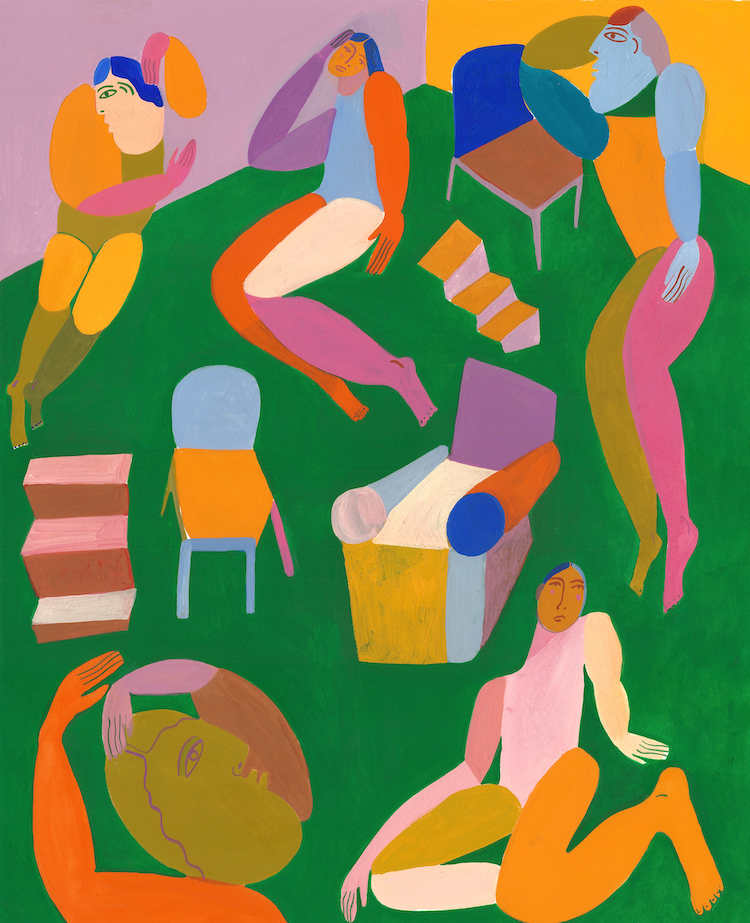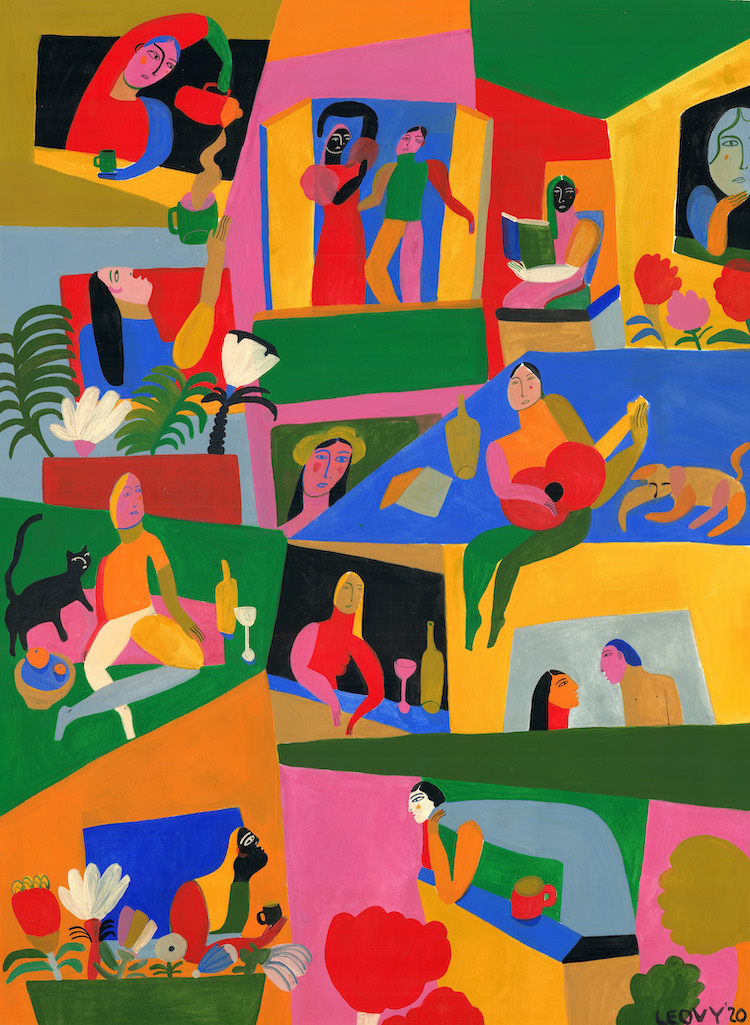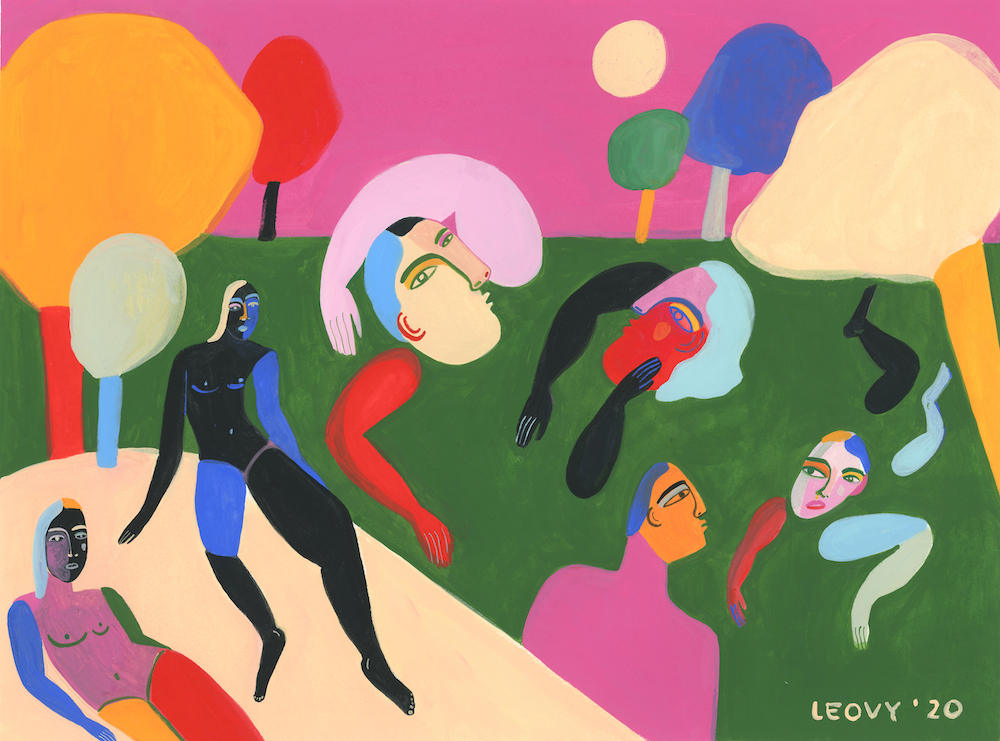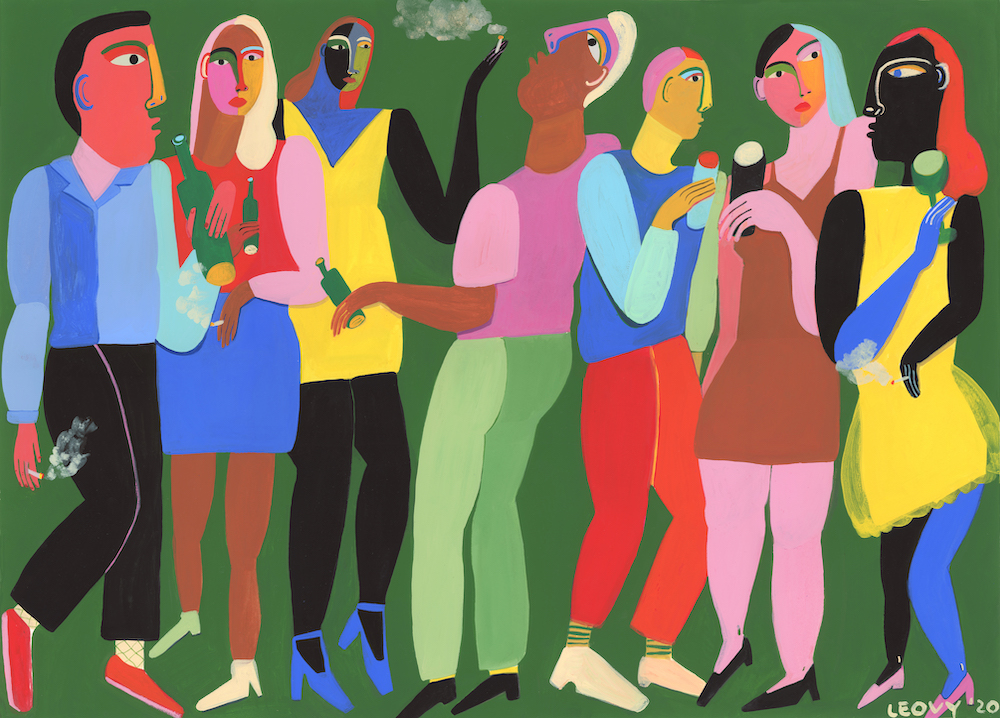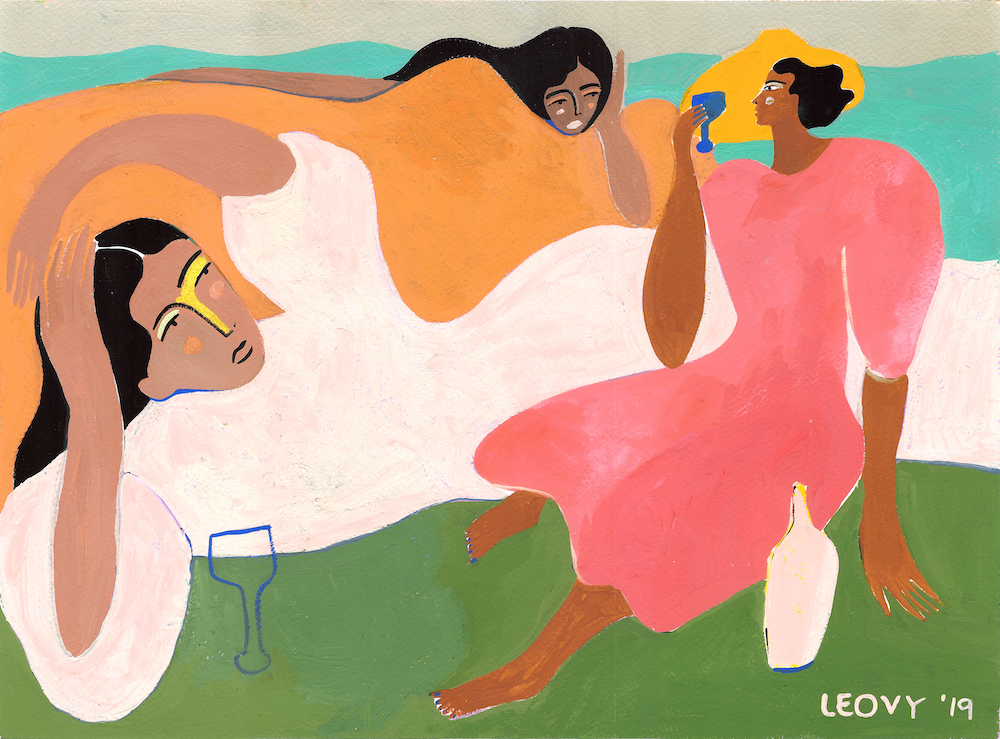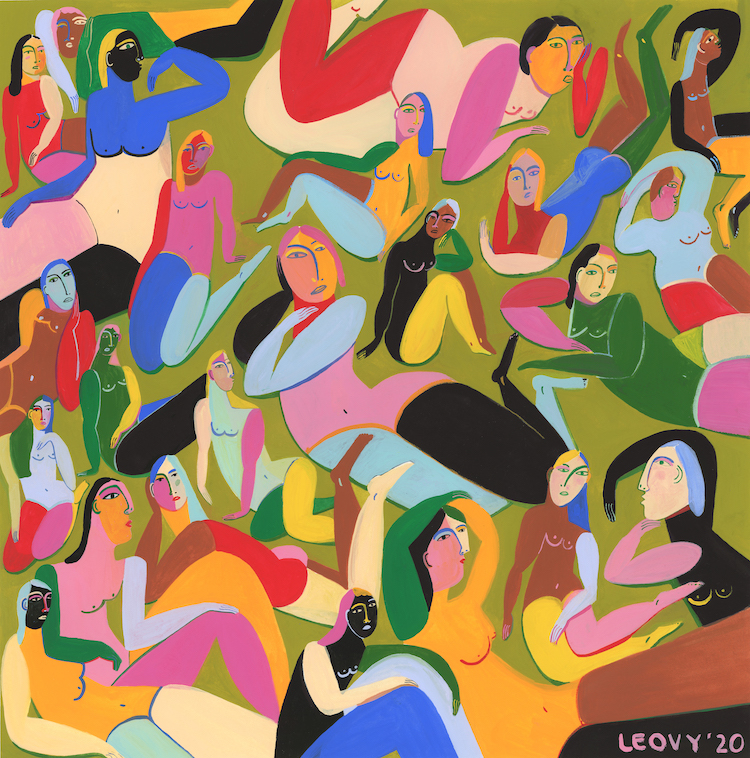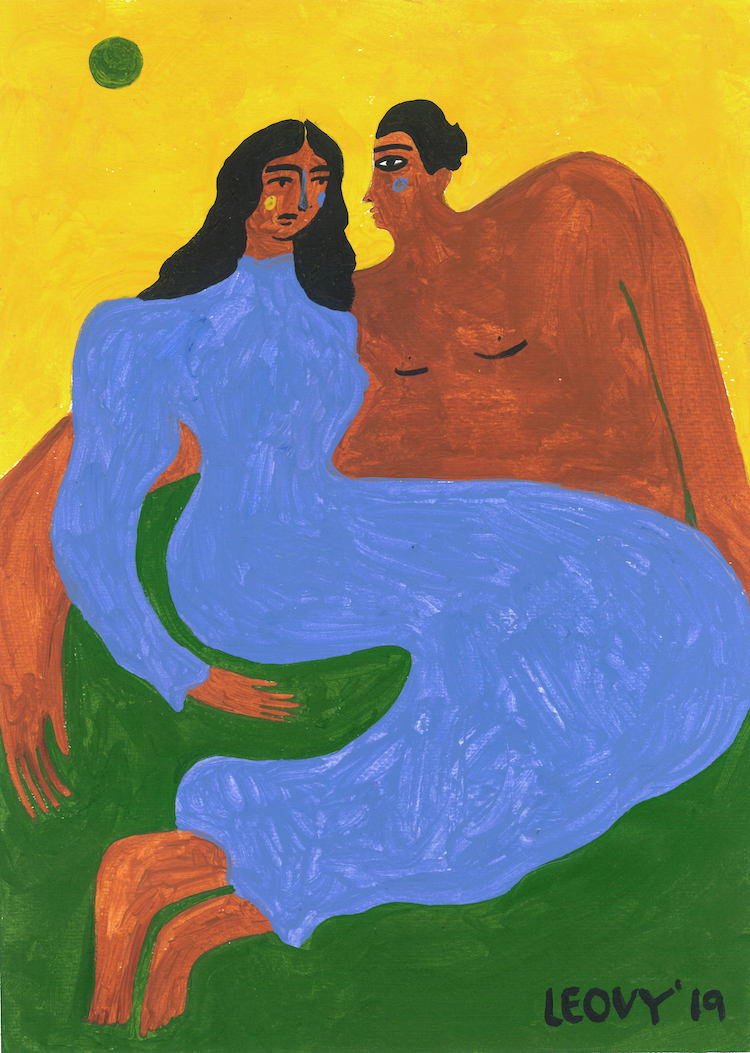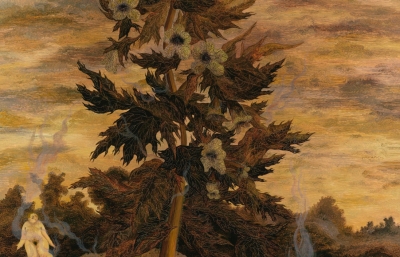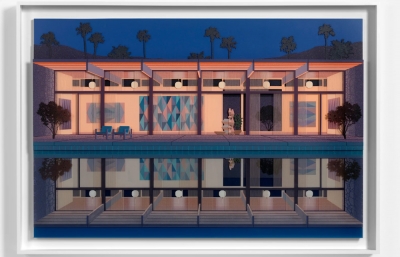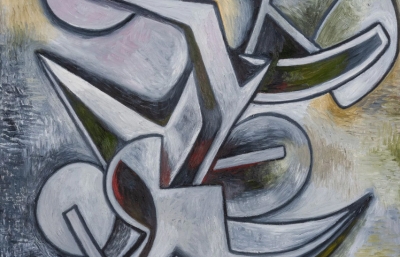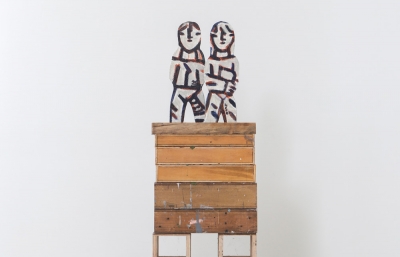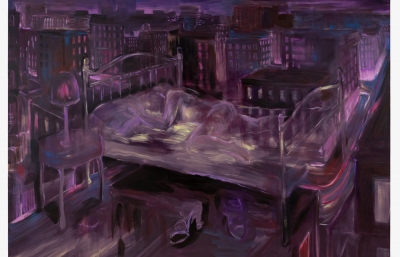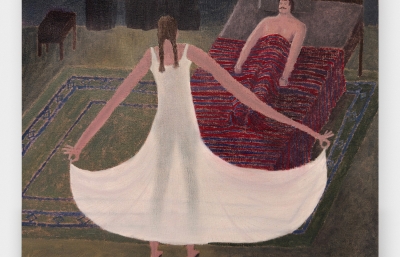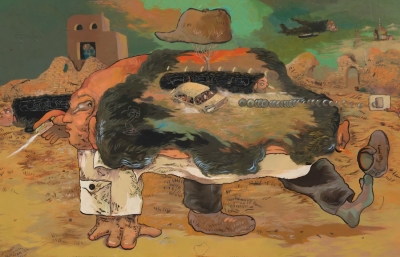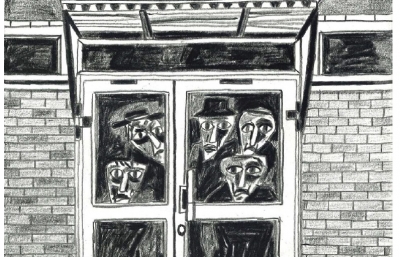Ana Leovy’s glass is half full, effervescent with bubbles, ready to toast the day and share the good news. Maybe on a solo stroll, maybe with friends and neighbors, the message is clear in her ripe gouache and acrylic pictures. Follow the light like a sunflower, lounge proud with purpose. A tropical storm delayed our conversation, but didn’t dampen her spirits.
Gwynned Vitello: Your work has real vibrancy and immediacy, so I can see how you got lots of work as a graphic designer. The paintings kind of burst and sing, but I guess you felt boxed in doing corporate work. Tell me about your transition to full-time painting.
Ana Leovy: Thank you! Painting has always been my passion, and, as a kid, I always dreamed of being a painter. I initially wanted to major in visual arts, but ended up going for a “safer” choice and studied graphic design, out of my fear of not being able to have a successful career, of not making a living. Although it was not my dream job initially, I don’t regret choosing graphic design as a career. I ended up loving it and I’m grateful because it gave me so many tools I use today.
I started transitioning to full-time painting about three years ago. I’d been working as a designer in an ecommerce start-up in Mexico City, completely fed up with the routine and the long commute. It was a good job, but I felt like there was something missing and it felt wrong to stay there any longer. I decided to move to Barcelona and did a masters in graphic design applied to illustration. I think that was my true beginning! My love for design grew while discovering creative sides within illustration. Spain was particularly special to be because I was surrounded by people who lived off art and inspired and pushed me to do the same. I had lots of spare time between classes, so that allowed me to get back to my sketchbook and let it all out. It was very cathartic.
So who or what inspires you? Are most of the subjects interpretations of yourself, as well as fictional characters, famous folks and friends?
They are definitely extensions of myself, of my thoughts and emotions. These characters are not normally based on anyone in particular, unless it is a commissioned work, where I’ll get asked to do a representation of a real person. But to be completely honest, doing this makes me a bit nervous. Even though I am not aiming to be realistic with my style, the fact that there are actual people involved reduces my creative freedom, in a way. So I have avoided this sort of work lately, focusing more on personal pieces, where my characters are completely made up.
Don’t get me wrong! I also get lots of satisfaction when doing commissions based on existing people. I love how intimate and meaningful this is, but I also think it’s important to step back every now and then and continue this exploration on my own so that my work evolves. What ignites my inspiration constantly changes, but lately I find myself needing to portray social scenes like groups of people dining together, dancing, kissing, hugging, simple activities we all took for granted and were taken away. I guess I am craving all of that. Nostalgia is very present in my work. I think there is a lot of beauty in sadness.
Rumor is that you practice blind contour drawing. True? How much of that comprises your practice, and does that mean you don’t do rough sketching?
I think blind contour practice influenced my distorted traces and how I play with shapes and proportion. But I do it more as a personal exercise to relax my hands and mind. My current figures are a bit more planned and defined, so there is a sketching process involved, for sure.
This way of drawing fascinated me since the first time I learned about it back in high school art. I love the element of surprise, not knowing how it will turn out when you finally look at a page that was blank a moment ago. It also helps me be more present, even if it’s just for a couple of minutes, to observe a real life object and all its details. We don’t take time for observation now, always going at such a fast pace and with so much content constantly thrown in our faces. I really struggle with the amount of screen time I am using per day, especially since quarantine, and it makes me very anxious. I’ve been doing a little exercise for a couple of weeks, doing a quick contour self-portrait drawing in the mornings as soon as I walk up. It helps me start off my day more relaxed.
Do people sit for your portraits, and when they do, are they seeking a certain look?
When I do portraits of real people, it’s never face to face. The majority of my clients are international, so they send me photos and we have tons of conversations that will help me capture their essence. Since I am a realistic artist, I focus more on the personalities, their likes and signature traits.
Have you consciously made a self-portrait?
Aside from the contour drawing experiment I’ve been doing (and old school projects) I haven’t done any self-portraits, though I definitely see myself reflected in some of the women I paint. I guess that’s inevitable! I may do it as an exercise at some point, but at the moment, it isn’t interesting to me. I like it when the characters are not so real so that anybody can relate.
Do you ever do black and white? Does it work for you at all?
I did some charcoal and pencil drawings when I was younger, and I still enjoy them because black and white is very romantic somehow. When choosing color, it isn’t something I do consciously, but I lean more towards colorful palettes because their variety brings out a whole new meaning and resonates more with what I want to say. It’s important to me to showcase diversity within my characters, and I don’t feel I have that ability when using only black and white. I also find color very compelling, how it can speak to everyone in a different way and have so much impact.
I find color to be some sort of personal diary, so things I can’t say with shapes or words, I say with color. It’s funny because sometimes the concept behind my work is not very cheerful, even though my selection of paint seems to say the exact opposite. I enjoy playing with this juxtaposition because I believe that there are so many hues in feelings and how each one of us sees the world. Certainly, when I find myself down, color gives me positive energy, and hopefully this happens to other people as well when they see my work.
How does place play a part in your work, starting with going to school in Spain and then going back home to Mexico? How has the transition been from Mexico City to Cancún?
I’m someone who gets bored easily when I spend too much time in the same place, so I tend to move around a lot to spice it up. I am very lucky because I can take my work almost anywhere I go, so travel helps when I am feeling stuck or anxious. I’ve lived in many places, but I think Spain was the turning point. I was doing my Masters, which was really exciting, and it was also the first time I lived completely on my own. This meant plenty of time for myself, so I learned and focused on my creative side more than ever, which led me to where I am today. I was also impacted by the lifestyle and surroundings. I was able to walk everywhere (love walking!), go to parks or cozy cafes to sketch, read and listen to music. I felt so free and inspired! When I came back to Mexico City, I was not able to do that. It just wasn’t a place where I felt comfortable walking alone as a woman. I will always be fond of it; I still like visiting, I have lots of friends there and it’s quite fun! But I chose Cancún for a different quality of life and to be close to my family.
That said, moving from the city to the beach has not been super easy, let me tell you. I do not enjoy sweating constantly or sharing my apartment with spiders. The humid temperature actually affects my work as I’ve had to learn to adjust and paint faster so that materials don’t dry up before I’m done. I also cannot store a huge stock of art supplies because the consistency changes. I’m learning little things along the way, but overall, I do feel happier for now.
What are your feelings on living and working in the studio, in terms of scheduling, lighting, atmosphere?
At the moment, I’m working from home where I have a studio and do everything. I'm definitely needing to have more space for the larger paintings, but I’m still a bit hesitant to have a studio separated from my home. I like that I can wake up very early and go straight to my art room, or even when I can’t sleep. I guess I’ll always have a space for this even if I move outside of my apartment.
What part of graphic design work do you especially miss?
Branding! Particularly naming, playing with words. Creating the logo, choosing typography, color palette and everything in the process is seeing an idea come to life. I don’t think people give design the credit it deserves.
I think painting will always be a part of your artistic life, but I can imagine you designing clothes or living spaces.
Ooh, I actually was debating between graphic, fashion or interior design before going to university. I find them all very appealing, so who knows? I am definitely open when it comes to new areas where I can explore my creativity. I don’t ever think I would leave painting by choice though. Maybe I would do a capsule thing or collaboration, but I don’t dare want to deal with all the rest.
You are such a social person, so I think that making art is definitely a kind of dialogue for you. What’s your favorite aspect of the creative process?
It’s hard to narrow it down, but I even get excited from just choosing the materials, and the process of painting is soothing and energizing at the same time. But there is no better feeling than knowing that somebody out there has connected with your work. This morning I went for a doctor’s appointment and while chatting with a lady at the counter (whom I’d never seen before) she noticed my name and said, “Oh, I have one of your paintings in my house.” What? The world is so small. I love it.
This article was originally published in the Winter 2021 Quarterly

